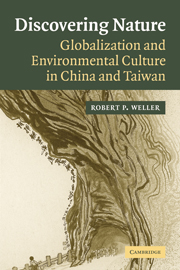Book contents
- Frontmatter
- Contents
- List of illustrations
- Acknowledgments
- 1 Discovering nature
- 2 Night of the living dead fish
- 3 New natures
- 4 Stories of stone
- 5 Garbage wars and spiritual environments
- 6 On “policies from above and countermeasures from below”
- 7 Globals and locals
- List of Chinese characters
- Bibliography
- Index
2 - Night of the living dead fish
Published online by Cambridge University Press: 05 June 2012
- Frontmatter
- Contents
- List of illustrations
- Acknowledgments
- 1 Discovering nature
- 2 Night of the living dead fish
- 3 New natures
- 4 Stories of stone
- 5 Garbage wars and spiritual environments
- 6 On “policies from above and countermeasures from below”
- 7 Globals and locals
- List of Chinese characters
- Bibliography
- Index
Summary
Anthropologists make it a point of pride to eat anything, although Chinese banquets can sometimes challenge the ethic. I have eaten camel's paws and toad's toes, caterpillars and snakes, and even a few dogs. The one meal that lingered in my mind for years afterwards, however, was the night of the living dead fish. The “living dead fish” itself was no greater a challenge to my gastronomic relativism than the others – I have hesitated longer over lima beans – but the event left me puzzled.
The meal took place in the foreigners' dining hall at Nanjing University, where I was living at the time. It was a banquet to celebrate the end of a study abroad program, and I was seated at a table with some of the American students and some of the Chinese administrators and faculty involved in the program. The hosts proudly explained that they had ordered the highest-quality available menu, featuring the chef's signature dish, his claim to fame, “living fish” (huoyu). They seemed quite excited, and described it for me in some detail.
I have asked people about this dish in the intervening years. Some have never heard of it, and others know quite different versions. As this chef prepared it, the result was a large, whole fish with the meat nicely cooked and the nervous system still sufficiently alive to have it twitch and squirm on the platter.
- Type
- Chapter
- Information
- Discovering NatureGlobalization and Environmental Culture in China and Taiwan, pp. 19 - 42Publisher: Cambridge University PressPrint publication year: 2006

